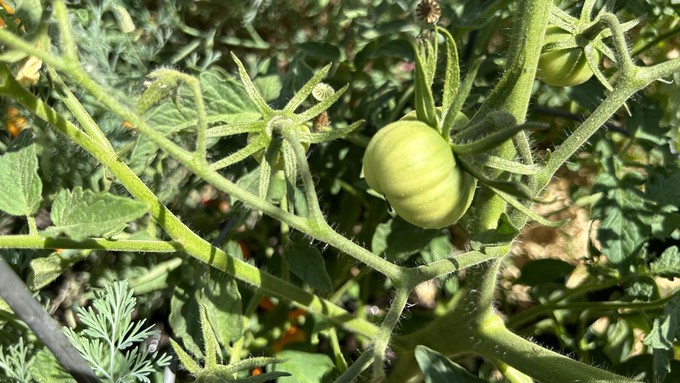
Windy conditions will keep temperatures below average during last days of spring

Tomatoes are in progress! They're developing nicely as we move into summer. Kathy Morrison
Hold onto your hat – and your trellises, too. According to the National Weather Service, we’re in for a windy weekend – and cooler temperatures.
The NWS Sacramento office says to expect “locally gusty onshore winds this weekend. Avoid outdoor burning. Secure loose outdoor items and temporary structures.”
In Sacramento, expect gusts of 20 to 25 mph on Sunday, Father’s Day, with the breeze building in intensity after 5 p.m. That pattern repeats almost every day this next week; light breezes earlier in the day with gusty conditions in late afternoon and early evening.
These breezes will keep temperatures down. After a normal high of 86 on Saturday, Sacramento will be back in the 70s on Monday and Tuesday with high temperatures hanging in the low 80s through next weekend.
Nights will be on the cool side, too. After a 60-degree low on Sunday night, overnight temperatures will dip down into the low 50s. Average low for mid-June in Sacramento: 56 degrees.
Unlike recent days, we’ll see little cloud cover; those breezes will make for very sunny skies.
Make the most of these last days of spring and dive into serious summer gardening (preferably before the wind kicks up).
Although temperatures will be below our June averages, it’s still plenty warm for fast-developing tomatoes, squash and peppers. Keep plants evenly watered and they’ll keep growing strong.
* Mulch, mulch, mulch! That wind can dry out soil. This “blanket” keeps moisture in the soil longer and helps your plants cope during summer weather.
* Tie up vines and stake tall plants such as gladiolus and lilies. That gives their heavy flowers some support (especially during windy conditions).
* Let the grass grow longer. Set the mower blades high to reduce stress on your lawn during summer heat. To cut down on evaporation, water your lawn deeply during the wee hours of the morning, between 2 and 8 a.m.
* Dig and divide crowded bulbs after the tops have died down.
* Feed summer flowers with a slow-release fertilizer.
* Avoid pot “hot feet.” Place a 1-inch-thick board under container plants sitting on pavement. This little cushion helps insulate them from radiated heat.
* Thin grapes on the vine for bigger, better clusters later this summer.
* Cut back fruit-bearing canes on berries.
* Feed camellias, azaleas and other acid-loving plants. Mulch to conserve moisture and reduce heat stress.
* Cut back Shasta daisies after flowering to encourage a second bloom in the fall.
* Trim off dead flowers from rose bushes to keep them blooming through the summer.
* Pinch back chrysanthemums for bushier plants with many more flowers in September.
* From seed, plant corn, melons, pumpkins, radishes, squash and sunflowers.
* Plant basil to go with your tomatoes.
* Transplant summer annuals such as petunias, marigolds and zinnias.
* Transplant perennial flowers including astilbe, columbine, coneflowers, coreopsis, dahlias, rudbeckia, salvia and verbena.
Comments
0 comments have been posted.Sacramento Digs Gardening to your inbox.
Sites We Like
Garden Checklist for week of April 21
This week there’s plenty to keep gardeners busy. With no rain in the immediate forecast, remember to irrigate any new transplants.
* Weed, weed, weed! Get them before they flower and go to seed.
* April is the last chance to plant citrus trees such as dwarf orange, lemon and kumquat. These trees also look good in landscaping and provide fresh fruit in winter.
* Smell orange blossoms? Feed citrus trees with a low dose of balanced fertilizer (such as 10-10-10) during bloom to help set fruit. Keep an eye out for ants.
* Apply slow-release fertilizer to the lawn.
* Thoroughly clean debris from the bottom of outdoor ponds or fountains.
* Spring brings a flush of rapid growth, and that means your garden is really hungry. Feed shrubs and trees with a slow-release fertilizer. Or mulch with a 1-inch layer of compost.
* Azaleas and camellias looking a little yellow? If leaves are turning yellow between the veins, give them a boost with chelated iron.
* Trim dead flowers but not leaves from spring-flowering bulbs such as daffodils and tulips. Those leaves gather energy to create next year's flowers. Also, give the bulbs a fertilizer boost after bloom.
* Pinch chrysanthemums back to 12 inches for fall flowers. Cut old stems to the ground.
* Mulch around plants to conserve moisture and control weeds.
* From seed, plant beans, beets, cantaloupes, carrots, corn, cucumbers, melons, radishes and squash.
* Plant onion sets.
* In the flower garden, plant seeds for asters, cosmos, celosia, marigolds, salvia, sunflowers and zinnias.
* Transplant petunias, zinnias, geraniums and other summer bloomers.
* Plant perennials and dahlia tubers for summer bloom.
* Mid to late April is about the last chance to plant summer bulbs, such as gladiolus and tuberous begonias.
* Transplant lettuce seedlings. Choose varieties that mature quickly such as loose leaf.